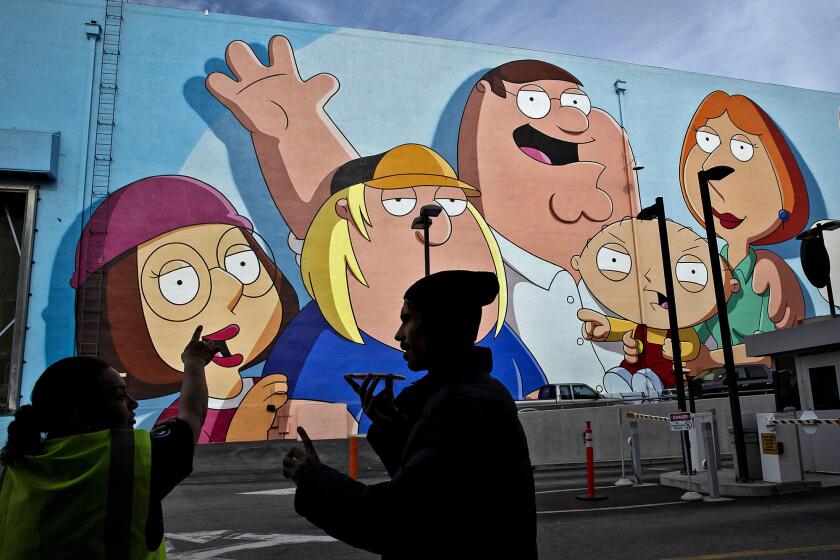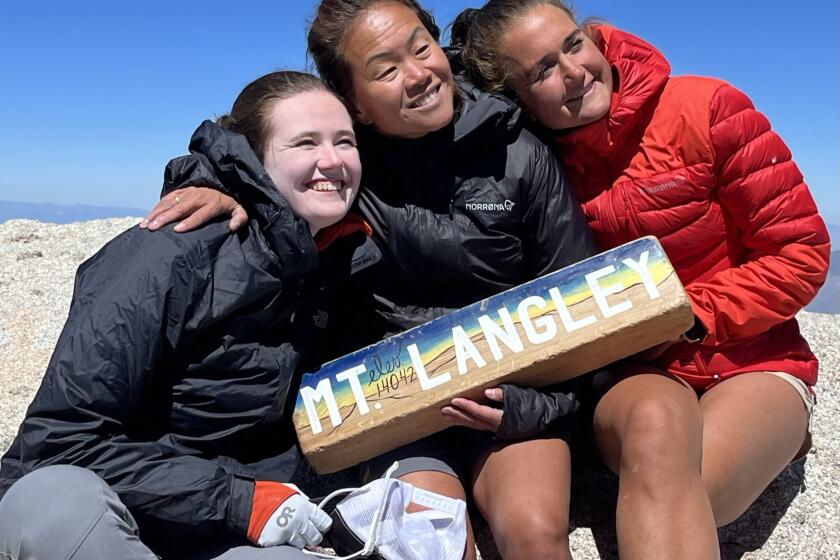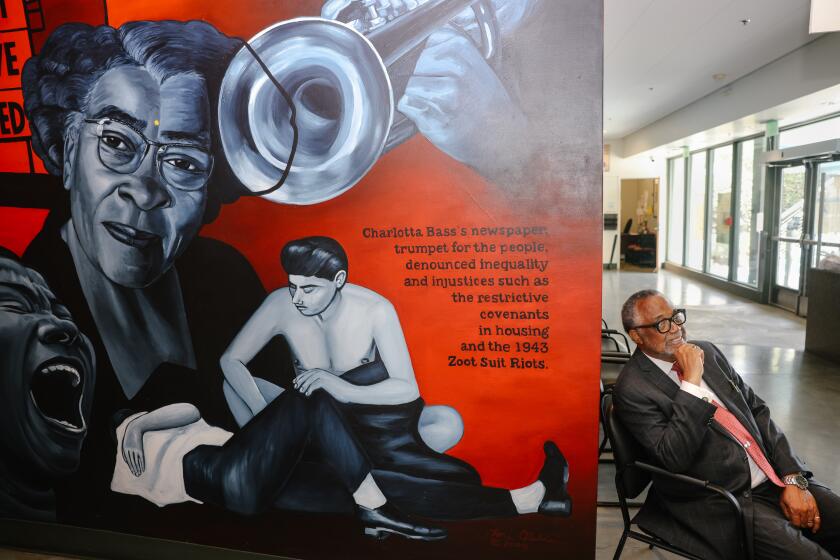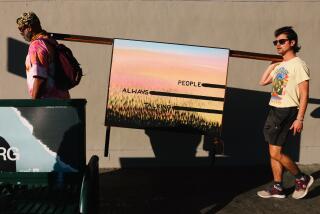End of an era: One of Hollywood’s last scenic painters can’t quite put down his brush

In his faded jeans, button-down shirt and sneakers that betray a hint of paint speckles, Mike Denering cut an unassuming figure ambling across the Fox Studios lot in Century City.
But as he made his way through the famed commissary and onto the sun-splashed backlot, an assortment of crew members, who barely raise an eyebrow around marquee-name actors and directors, perked up in his presence. “Hey man!” hollered one excitedly. “Good to see ya,” said another.
The scene unfolded over and over again; sometimes with a shoulder bump, sometimes with high-fives, as Denering walked past the giant soundstages and onto New York Street built for the film “Hello Dolly!” A clutch of grips, gaffers and others rushed up to greet him.
They all asked him some version of the same question: “What are you doing here? I thought you were retiring.”
To each, Denering gave the same deadpan response. “I can’t. They keep throwing money at me.” It’s something of an inside joke and every time he punched the line, everyone chortled.
At 66, Denering is one of Hollywood’s last scenic painters. He estimates that only about six journeymen — the title given to masters of the craft — remain. “If I had to find a crew,” he said, “I’d have a hard time finding one.”
At one time there were hundreds, perhaps thousands, of these men and women, trained in the apprentice system, who hand-painted massive backdrops, stunning in their ability to trick the mind’s eye. By manipulating color, light, scale and perspective, generations of these hired brushes created entire fantasy worlds like the Emerald City in “The Wizard of Oz,” or re-created Mount Rushmore in “North by Northwest,” and conjured up the Himalayas in “Lost Horizon.”
“Scenic art is critical to the language of film and to what we understand of the cinematic experience,” said Karen Maness, co-author of the seminal book on the subject, “The Art of the Hollywood Backdrop.”
So impeccable was the re-creation of the Sistine Chapel in the 1968 film “The Shoes of the Fisherman,” as the book recounts, that Catholic priests were heard expressing their shock at its premiere: “I thought they were not going to allow them to film inside the chapel.”
Today, backdrops are largely digitally printed photographic enlargements or images and video streams layered together and projected onto a green screen. Ravaged by the shift to digitization and the exodus of movie production outside of Los Angeles, the art of backdrop painting is yet another casualty of a swiftly changing Hollywood.
Over his four-decade career, Denering worked for all of the studios and the preeminent shop, J.C. Backings, creating backdrops for more than 200 movies. He produced hallways that appeared to stretch into infinity. He fashioned underworlds, cityscapes and jungles. He got to see the world through his paintbrush: a vast, eccentric portfolio of deserts, spaceships, suburbs and baroque angels.
“One of the best,” Maness said of him.
Sometimes reporting a story is like shaking a tree: You rattle one branch and an entirely different limb swings into view.
At Fox Studios, his brushstrokes are everywhere, literally. Denering painted many of the giant murals gracing the soundstages’ exteriors, as well as the backdrops for numerous movies and TV shows filmed inside of them.
Standing under the 160-by-50 foot mural of Marilyn Monroe and Tom Ewell in a scene from “The Seven Year Itch” — Denering restored the 1995 work in 2016 — he pointed out an odd-shaped tall, white building with large windows nearby. It was once Fox’s backings building, where Denering and those who came before him worked.
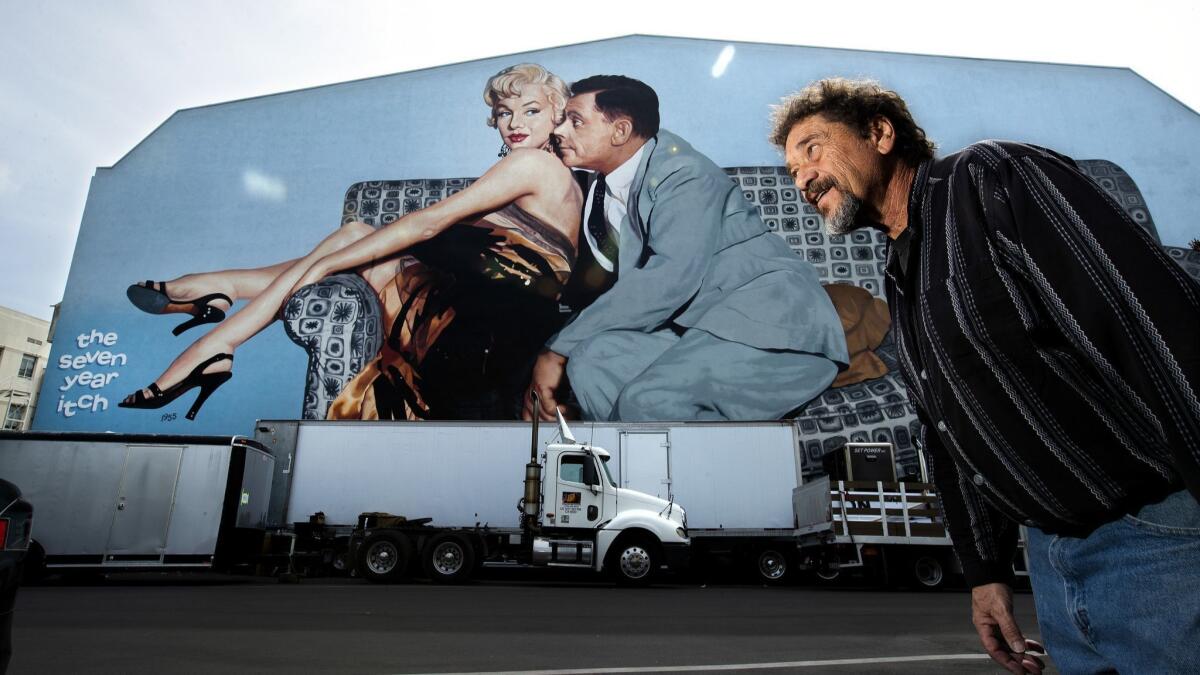
“You see the light in between the windows?” he said with a gesture. “There was a floor there that went out, that’s where we used to stand inside to paint. They turned it into an office building,” he said wistfully. It is now Ryan Murphy’s production offices.
Last year, Denering was ready to retire. Then he got the call to do one last show. It was HBO’s “Deadwood” movie.
“I always wanted to go out on a western,” he said. “They’re something I grew up with when I was a kid.” He spent months working at the historic Melody Ranch Studio, the same location where John Wayne, Gary Cooper and Roy Rogers made their westerns.
It was a satisfying final act in a career not lacking in gratifying moments. But then the phone rang again. A new series set in 1930s Los Angeles for Showtime, “City of Angels,” needed a scenic painter.
It was March. By then he’d already submitted his retirement papers to the Motion Picture Industry Fund.
Denering rolled over the job in his mind. “I’ve been doing this for 41 years. I’m tired,” he said. He’d survived Hollywood’s boom and bust cycles. He was at the top of his game and he was at the end of it, but he also couldn’t resist the prospect of one more gig. “I like to work. I’m one of those people that don’t like to sleep,” he said. “The chance to create stuff is great.”
Besides, “I’m not ready to put down my brush.”
He clawed back his papers.
From novice to master
It was 1976 and Denering was bored. He was working as a graphic designer at an advertising agency when someone came into the office with a calendar. A single page stopped him flat. It depicted a giant 100-by-50 foot wall at Paramount Studios filled with clouds. “I thought, my God, somebody actually painted these beautiful clouds,” he said. “I want to do that.”
Denering, who grew up in North Hollywood, had taken some art classes at Otis College. But when he turned up at the scenic artists local union, he was told, “go take your portfolio” — which he said was all graphics — and “go out and paint, paint trees, go out and paint rocks and go out and do something more realistic.” A month later Denering returned only to be told, “OK, now go do figures.”
Thinking that he was being strung along, Denering announced, “I’m not going to leave this office until I get a job.”
He landed as an apprentice at CBS Television Studios. “I went from $20 an hour to $4.75 an hour,” but he said, “I wanted to follow the trail of the big cloud paintings and I knew that in the future it would pay off … but you had to pay your dues.”
Novices learned the craft through the master-apprentice system. It took as long as a decade to become a journeyman. The master ruled the studio while their proteges learned by cleaning brushes, priming canvases — and observing.
“It was the studio system,” he said, “the same used by Michelangelo. If they asked you ‘get coffee,’ you stop what you’re doing and get coffee. If they want water, you stop and get clean water. It was almost medieval.”
There were a few women, but the craft, like Hollywood, was dominated by men. “These were rough, tough men. They weren’t sitting around with a little brush,” he said.
For a time, Denering restored historic MGM backdrops, giving him another window into the masters of the craft. “He learned through ghosts,” said Maness.
“It took several years just to become prolific in basic perspective,” Denering said. “We were turning something into a three-dimensional object with just paint so you have to know your skills, color, Chroma, classic painting and all that but also scale. That only comes with time.”
Later, Denering pulled up some images he created for films, including “Lemony Snicket” and “Batman,”on his computer. “We were masters at creating large images,” he said. “When you’re painting a house — you know, the front of a house with a two-story, that’s 30-feet high — you have to figure out the right scale from wherever the camera is going to be. It’s a lot of technical thinking and math.”
While such backdrops transported filmgoers into new worlds, the scenic artists who made them remained behind the scenes. “We knew that if it did blend in, and if you couldn’t tell, then you achieved what you wanted to,” Denering said.
To this day, scenic artists do not receive on-screen credit for their work, and while others in the crafts fields such as production design and makeup artists have their own awards categories, scenic artists do not.
Starting out at CBS, Denering worked on “The Carol Burnett Show” and “Jeopardy.” “Carol Burnett was just the nicest lady you ever met in your life,” he said, brightening. “The whole cast was that way. You knew they would improvise just about everything because they were so good together. We would work in the shop and we’d sneak out and go watch as they went through rehearsal.”
Denering left CBS to work in theater painting sets at the Mark Taper Forum and the Dorothy Chandler Pavilion. He liked nothing better than going to the theater on opening night. “Everything would come to life. And it was really magical. I really fell in love with that. I did that for about a year and then theater kind of died in L.A. I had to move on again.”
Denering’s time in Hollywood’s trenches has given him a jaundiced view toward celebrity. “I don’t get star-struck very often,” he said.
But Steven Spielberg made an impression during the shooting of “AI” and “War of the Worlds” — mostly, Denering said, because he had an entourage with him and “they’re all like, ‘Yes, you’re right. Yeah, you’re right.’”
While working on “A Few Good Men,” he recalled painting a hallway as Jack Nicholson was about to begin a scene. “We started talking. He knew exactly what he was doing. Then this girl walks in, she’s a PA, so Jack starts putting the moves on her and I thought man, that’s Jack. He got his cue, went to open the door and started acting. He was a pro.”
Creating playgrounds
Sitting in his home studio, Denering waxed nostalgic about the time he worked on six films back-to-back. “Those days were glorious.”
In 1989, Denering bought a house in Sun Valley, a drowsy rustic community at the base of the Verdugo Mountains about 15 miles north of Hollywood. It was the same year he worked on four blockbusters, including the sequels to “Lethal Weapon.” Denering built a studio out back. He still likes to mix his color palettes here and it’s where he goes to create his own artwork.
Sometimes he takes his easel outside. When Denering started, scenic artists often painted in the plein-air technique — working outside to be able to replicate the gradations of light and color in nature. “We originally did plein-air on the weekends to help us develop our craft,” he said.
Much of Denering’s personal work involves landscapes. The walls of his house are lined with many of them. “I do paintings of my own because I can do whatever I want and I’m not being told what to do,” he said. Pausing briefly, he noted the irony in amassing the skill required of a scenic artist, only to sublimate one’s own talent for someone else’s vision.
Over time, Denering learned to become less precious about his work. He stopped going to the cinema to see the films, “because I didn’t want to see how they wrecked it or how they shot it ... I didn’t want to be disappointed.”
The 2001 remake of “Planet of the Apes” was one such movie. “We did all this wonderful jungle,” he bemoaned. Then the director of photography came on set. “He was this little French guy and he goes, ‘I have been to the jungle. Everything is dark, turn off all the lights.’ So all that work is never seen because he decided he didn’t want to light it. That was disappointing.”
Looking back, he concluded, “We created playgrounds. And when an actor came out they got to see a different world that helped them act. Nowadays with the green screen and everything, they come out and they have to really be an actor or they don’t have anything to go with.”
Back at Fox, Denering pointed to the movie billboards that grace the lot. At one time they were all hand-painted. Now they’re churned out by giant printers.
In the early ’90s, Denering was working at Warner Bros. when a group of Japanese technicians came through with big cameras capable of simulating hand-painted backings. “I thought, oh man, here we go. We got a sample of what they printed. It was so blurry and horrible that we didn’t worry about it, but we knew it was coming.”
One last show
Denering has never been one for downtime. While waiting for word from Showtime, he has picked up a spate of short-term jobs here and there. Not long ago he took a gig re-creating the neon lights of the Las Vegas Strip when “Jimmy Kimmel Live!” taped in Sin City.
Earlier this year on a cold morning, Denering could be found maneuvering an electric lift down from two stories to the sidewalk on Melrose Avenue. Since 7 a.m., he’d been painting the signage on a brick wall outside the Ralph Lauren Double RL, the designer’s rustic outpost in Hollywood.
“The slow periods are getting longer and more difficult to schedule,” he said. “I take these jobs when I have to.”
While the work has slowed down, Denering hasn’t. He’s always wanted to work at the Vatican. “They have a museum and they do a lot of trompe l’oeil stuff on the walls to decorate the exhibits.”
Denering has spent a lot of time thinking. “You spend a whole lifetime learning a craft and then it disappears,” he said plaintively. “When I first started, I thought, ‘God this is great, I can learn all the things I need to learn as an artist.’ When you’re young you have thoughts in your head but you don’t have the ability to be able to do it with your hands. Well, now I do. I can do whatever I think of.”
But first he has one last show in him.
The call finally came in July, four months after Denering delayed his retirement for the second time. The “City of Angels” production team from Showtime gave him a start date.
“This is a big job,” he said excitedly. He insisted that this would be his “last hurrah. I’m going to put my brush down in the movie business.” Then he clarified, “But I’m still going to be painting — my stuff.”
More to Read
Inside the business of entertainment
The Wide Shot brings you news, analysis and insights on everything from streaming wars to production — and what it all means for the future.
You may occasionally receive promotional content from the Los Angeles Times.
